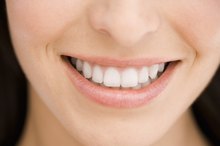What does fact checked mean?
At Healthfully, we strive to deliver objective content that is accurate and up-to-date. Our team periodically reviews articles in order to ensure content quality. The sources cited below consist of evidence from peer-reviewed journals, prominent medical organizations, academic associations, and government data.
- Journal of Conservative Dentistry: Dentin Hypersensitivity: Recent Trends in Management
- Journal of Conservative Dentistry: Dentin Hypersensitivity: Recent Trends in Management
The information contained on this site is for informational purposes only, and should not be used as a substitute for the advice of a professional health care provider. Please check with the appropriate physician regarding health questions and concerns. Although we strive to deliver accurate and up-to-date information, no guarantee to that effect is made.
Tooth pain associated with eating sweet, sugary foods can be irritating and frustrating.
The pain arises due to irritation of the internal tissue of the tooth, which can occur for a variety of reasons 16.
Common culprits include a cavity, a crack in your tooth or a condition called dentin hypersensitivity, among others 3. The nature and duration of the tooth pain along with a dental examination and x-rays will help your dentist determine the cause of your discomfort and best course of action.
Tooth Structure and Sensitivity
Each tooth is covered with a hard outer layer. Enamel covers the crown, the visible part of the tooth above the gum. Cementum covers the tooth roots. Dentin forms the middle layer of the tooth. This bone-like material encases the soft, innermost portion of the tooth, the pulp, which contains blood vessels and nerves.
Dentin comprises microscopic tubes that extend from its interface with the enamel or cementum to the interior pulp of the tooth.
Loss of enamel or cementum with dentin exposure frequently leads to tooth sensitivity caused by irritation of the nerves in the pulp of the tooth 1. Tooth sensitivity typically involves sharp pain of short duration that occurs in response to certain triggers, including: -- hot and cold foods or beverages -- sweet, sour and salty foods -- tapping, touching or drying the tooth
- Each tooth is covered with a hard outer layer.
- Dentin comprises microscopic tubes that extend from its interface with the enamel or cementum to the interior pulp of the tooth.
Cavities and Tooth Fractures
Causes of Pain in a Filled Tooth
Learn More
When tooth sensitivity associated with eating sweets develops abruptly, it often indicates an acute problem 1. You might have a cavity that has penetrated through the enamel into the dentin.
Or a crack could have developed in the affected tooth. A tooth crack, or fracture, can occur while chewing a hard substance or in response to a blow to your tooth. An acute tooth problem often causes sensitivity to several different triggers, so you might notice sharp pain with various types of food or beverages 1.
- When tooth sensitivity associated with eating sweets develops abruptly, it often indicates an acute problem 1.
- A tooth crack, or fracture, can occur while chewing a hard substance or in response to a blow to your tooth.
Dentin Hypersensitivity
Dentin hypersensitivity (DH) refers to tooth pain occuring in response to specific triggers that is not due to another dental problem, such as a cavity or tooth fracture 3.
Enamel or cementum loss with dentin exposure is the underlying cause of DH, which occurs most commonly in adults aged 20 to 40. DH can occur for a variety of reasons, including: -- age-related wear and tear -- overly aggressive tooth brushing -- receding gums or periodontal disease -- bruxism, or grinding your teeth
Short-term DH also occurs commonly after at-home or professional tooth whitening. In some people, no specific cause for DH can be identified.
Sugary foods -- as well as sour and salty foods -- are believed to trigger tooth pain associated with DH due to short-term chemical effects on the pulp that provoke nerve pain. Other triggers irritate the nerves of the pulp via other mechanisms.
- Dentin hypersensitivity (DH) refers to tooth pain occuring in response to specific triggers that is not due to another dental problem, such as a cavity or tooth fracture 3.
- DH can occur for a variety of reasons, including: -- age-related wear and tear -- overly aggressive tooth brushing -- receding gums or periodontal disease -- bruxism, or grinding your teeth Short-term DH also occurs commonly after at-home or professional tooth whitening.
Treatment
Tooth Pain After Eating
Learn More
Treatment for tooth pain associated with sugary foods depends on the underlying cause. A cavity may only require a filling if you catch it early. More extensive tooth decay may require a crown or root canal treatment. Treatment for a cracked tooth depends on the site and extent of the fracture 1. Similarly, the treatment for periodontal disease or receding gums depends on the severity of the condition.
Several treatments are available for DH. Over-the-counter toothpastes, mouthwashes and chewing gums that contain desensitizing ingredients -- such as potassium or fluoride salts -- might be effective for mild to moderate DH.
If these products do not provide relief, you dentist might recommend an in-office treatment, such as application of fluoride varnish or another mineral substance to your teeth. Your dentist will also advise you about dietary or dental hygiene practice changes to avoid further erosion of the enamel of your teeth.
- Treatment for tooth pain associated with sugary foods depends on the underlying cause.
- Similarly, the treatment for periodontal disease or receding gums depends on the severity of the condition.
Warnings and Precautions
It's important to schedule a visit with your dentist as soon as possible if you experience tooth pain, whether associated with eating sweets or not.
Pain is your body's way of alerting you that a problem exists, and it should not be ignored. A delay in treatment for tooth pain often leads to a more serious dental problem and a more costly repair -- or loss of the involved tooth.
Tooth pain sometimes indicates a serious problem that requires immediate professional attention. Seek urgent medical or dental care if you experience tooth pain accompanied by any warning signs or symptoms, including: -- sudden or worsening facial swelling or redness -- fever or chills -- difficult or noisy breathing
Reviewed and revised by: Tina M. St. John, M.D.
- It's important to schedule a visit with your dentist as soon as possible if you experience tooth pain, whether associated with eating sweets or not.
Related Articles
References
- Clinician's Guide to the Diagnosis and Management of Tooth Sensitivity; Sahar Taha and Brian H. Clarkson
- Essentials of Operative Dentistry; I. Anand Sherwood
- Journal of Conservative Dentistry: Dentin Hypersensitivity: Recent Trends in Management
- Journal of the Canadian Dental Association: Dental Pulp Neurophysiology: Part 1. Clinical and Diagnostic Implications
- Wheeler's Dental Anatomy, Physiology and Occlusion, 10th Edition; Stanley J. Nelson
- Dentistry Today: Differential Diagnosis of Toothache Pain: Part 1, Odontogenic Etiologies
- Fukuda KI. Diagnosis and treatment of abnormal dental pain. J Dent Anesth Pain Med. 2016;16(1):1-8. doi:10.17245/jdapm.2016.16.1.1
- Pihlstrom BL, Michalowicz BS, Johnson NW. Periodontal diseases. Lancet. 2005;366(9499):1809-20. doi:10.1016/S0140-6736(05)67728-8
- Heng C. Tooth Decay Is the Most Prevalent Disease. Fed Pract. 2016;33(10):31-33.
- Tonguc MO, Ozat Y, Sert T, Sonmez Y, Kirzioglu FY. Tooth sensitivity in fluorotic teeth. Eur J Dent. 2011;5(3):273-80.
- Yap AU, Chua AP. Sleep bruxism: Current knowledge and contemporary management. J Conserv Dent. 2016;19(5):383-9. doi:10.4103/0972-0707.190007
- Rechenberg DK, Galicia JC, Peters OA. Biological Markers for Pulpal Inflammation: A Systematic Review. PLoS ONE. 2016;11(11):e0167289. doi:10.1371/journal.pone.0167289
- Lubisich EB, Hilton TJ, Ferracane J. Cracked teeth: a review of the literature. J Esthet Restor Dent. 2010;22(3):158-67. doi:10.1111/j.1708-8240.2010.00330.x
- Shweta, Prakash SK. Dental abscess: A microbiological review. Dent Res J (Isfahan). 2013;10(5):585-91.
- Santosh P. Impacted Mandibular Third Molars: Review of Literature and a Proposal of a Combined Clinical and Radiological Classification. Ann Med Health Sci Res. 2015;5(4):229-34. doi:10.4103/2141-9248.160177
- Candamourty R, Venkatachalam S, Babu MR, Kumar GS. Ludwig's Angina - An emergency: A case report with literature review. J Nat Sci Biol Med. 2012;3(2):206-8. doi:10.4103/0976-9668.101932
- Yeo GS, Kim HY, Kwak EJ, Jung YS, Park HS, Jung HD. Cavernous sinus thrombosis caused by a dental infection: a case report. J Korean Assoc Oral Maxillofac Surg. 2014;40(4):195-8. doi:10.5125/jkaoms.2014.40.4.195
- Jacobsen PL, Casagrande AM. Sinusitis as a source of dental pain. Dent Today. 2003;22(9):110-3.
- Murphy MK, Macbarb RF, Wong ME, Athanasiou KA. Temporomandibular disorders: a review of etiology, clinical management, and tissue engineering strategies. Int J Oral Maxillofac Implants. 2013;28(6):e393-414. doi:10.11607/jomi.te20
- Becker DE. Pain management: Part 1: Managing acute and postoperative dental pain. Anesth Prog. 2010;57(2):67-78. doi:10.2344/0003-3006-57.2.67
- Guaita M, Högl B. Current Treatments of Bruxism. Curr Treat Options Neurol. 2016;18(2):10. doi:10.1007/s11940-016-0396-3
- Lee Y. Diagnosis and Prevention Strategies for Dental Caries. J Lifestyle Med. 2013;3(2):107-9.
- Kaptan RF, Haznedaroglu F, Basturk FB, Kayahan MB. Treatment approaches and antibiotic use for emergency dental treatment in Turkey. Ther Clin Risk Manag. 2013;9:443-9. doi:10.2147/TCRM.S52009
- American Association of Endodontists. (n.d.). Cracked Teeth. https://www.aae.org/patients/dental-symptoms/cracked-teeth/
- American Dental Association. (n.d.). Abscess (Toothache). https://www.mouthhealthy.org/en/az-topics/a/abscess
- Chow AW. (2018). Submandibular space infections (Ludwig's angina). In: UpToDate, Calderwood SB (Ed), UpToDate, Waltham, MA.
- Hennessy BJ. (2018). Merck Manual Professional Version: Toothache and Infection. https://www.merckmanuals.com/professional/dental-disorders/symptoms-of-dental-and-oral-disorders/toothache-and-infection?query=dental%20abscess
- Schweitzer JL. The Endodontic Diagnostic Puzzle. Gen Dent. 2009;57(6):560-7. https://www.ncbi.nlm.nih.gov/pubmed/19906608
- Ubertalli JT. Merck Manual. Professional Version. (2018). Pulpitis. https://www.merckmanuals.com/professional/dental-disorders/common-dental-disorders/pulpitis?_ga=2.233168734.1798272777.1553437191-365578483.1553437191
Writer Bio
Sophie Bloom has been a professional writer since 2000, writing for nonprofits including the American Foundation for the Blind and The Adult Literacy Media Alliance. She received her Bachelor of Arts degree in culture and media studies from Johns Hopkins University and her Master of Science in acupuncture from Tri-State College of Acupuncture in New York City.









